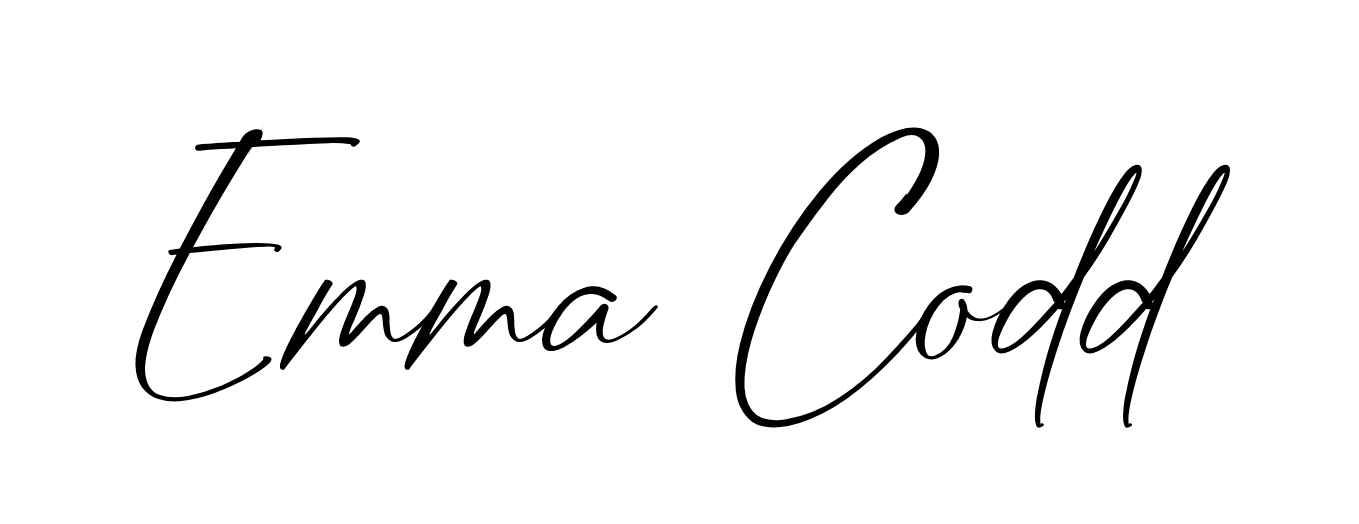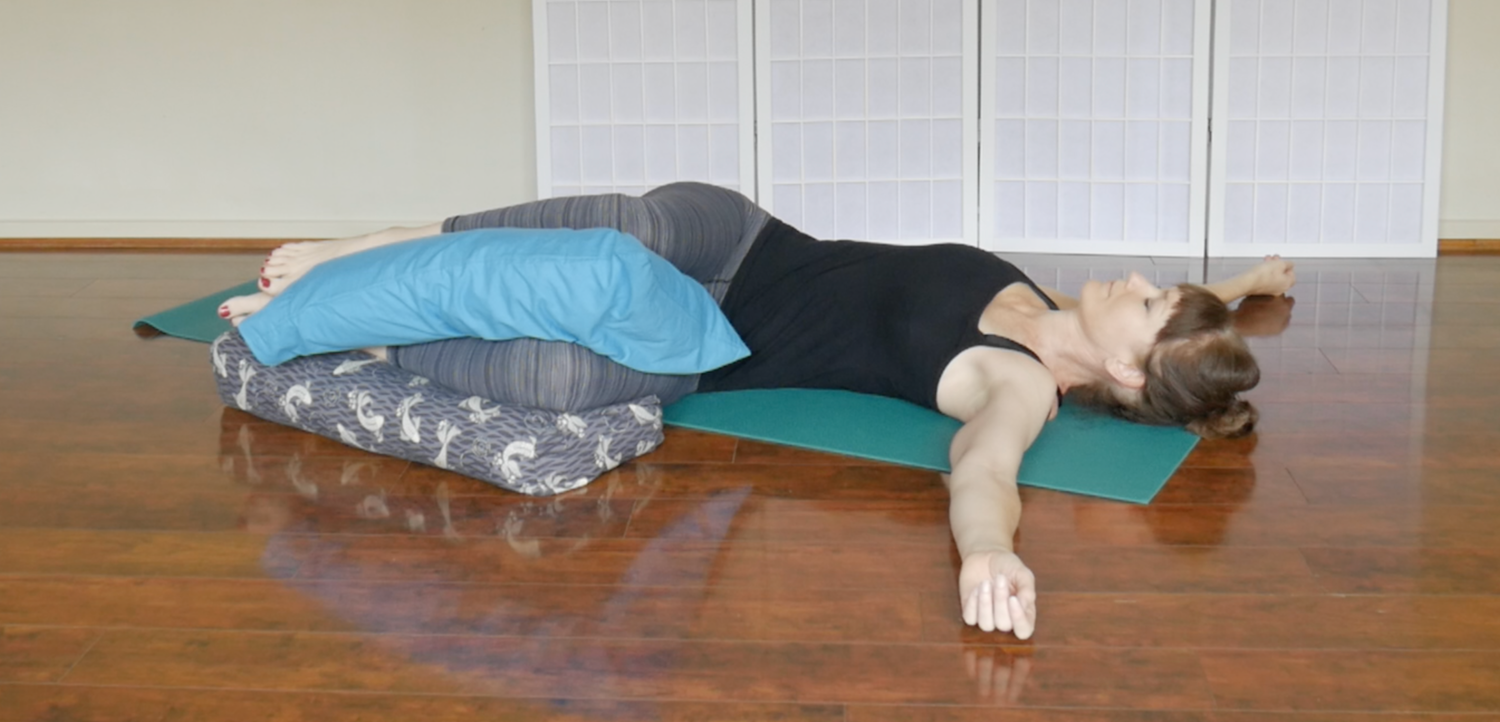Find Your Pose
Supported Reclined Twist
Supta Matsyendrasana
‘reclined lord of the fishes pose’
(supta ‘reclining’ + matsya ‘fish’ + indra ‘ruler’ + asana ‘pose’)
Reclined spinal twist is often included towards the end of yoga classes to help calm the body and mind. Supta Matsyendrasana, as it is known in Sanskrit, is also a nourishing addition to both Restorative and Yin yoga practices. It is important to note that, while reclined twists can be lovely poses for bringing a bit of movement to the joints of the spine, they can be aggravating for individuals with chronic back conditions. This is because they place quite a large load on the Sacroiliac joints. It is important, therefore, to adapt this seemingly gentle pose to suit your unique body, and to pay close attention to how the pose’s variations feel in your body. By taking time to find the right support for your body, rather than placing undue strain on the spinal joints you will safely mobilise them and, in time, build stability.
While exploring variations for your body, keep in mind that the joints of the upper spine naturally have more movement than those of the lower spine. Furthermore, as we age, it is the upper spine that tends to lose mobility. So, as you set yourself up in reclined twists, focus more on the opening and movement of the upper body (the variation below beginning in side-lying really highlights this). Also, remember that it is not important how a pose looks, but how it feels. Trust that what feels best for your body is the best option for you.
* Always consult with your doctor before beginning any yoga practice.
Benefits:
• Antidote for poor postural habits.
• Mobilises, rehydrates, and passively realigns the joints of the spine.
• Relaxes the muscles of the shoulders and upper back.
• Gently stretches and opens the chest, shoulders, neck, abdomen, ribs, and hips.
• Stimulates the digestive system, relieves gas, and improves circulation in the gut.
• Lessens menstrual discomfort.
• Calming and grounding for the nervous system.
Cautions & contraindications:
• This pose is not recommended for those with hip arthritis, a herniated lumbar disc, a hiatus hernia, or sacroiliac joint issues, particularly during a flare up. For any of these conditions, consult with your doctor or physical therapist before attempting to find a gentle variation that suits your body. • For all trimesters of pregnancy, be cautious with twists. Ensure you keep yourself well supported, and only take a very gentle twist, focusing on twisting through the upper spine only. I recommend using the variation starting in side-lying listed below. • For the second and third trimester of pregnancy, keep the torso elevated by reclining on a bolster positioned at a 45-degree incline with blocks elevating one end.
Step-by-step (the basic set-up):
Variation starting on your back:
This is the more common variation of this pose, though note how I recommend shifting the hips before twisting to set the spine up for better alignment once in the pose.
• Lie on your back with a bolster lying lengthwise beside your upper legs. Bend your knees with your feet flat on the floor. Position your arms along the floor in line with the shoulders, or further down, palms face down. • Press into your feet to lift the hips and move them slightly over to the right. Lower the hips back down to the ground. (This sets up the spine so it is better aligned after you’ve moved into the twist.) • Draw your bent knees in towards your chest, then take your knees over towards the floor on the left side. Let the bent knees and lower legs come to rest on the bolster. Turn your palms to face upwards. • At this point, add any additional props (from the ideas below) to offer your body maximum support in the pose. If you feel any pain, come out of the pose. • When you are ready to release from the pose, engage your abdominal muscles and slowly lift your knees away from the floor back up to centre. Place your feet back on the floor. • Pause here for a few breaths before repeating on the other side. (For the opposite side, shift the hips to the left and lower the knees to the right.)
Variation starting on your side:
This variation focuses more on twisting through the upper spine and finding stability through the lower spine. Some individuals with chronic sacroiliac and lower back conditions (myself included) can find comfort and ease with this variation, but still proceed with caution and consult with your healthcare provider first.
• Position a bolster lengthwise alongside your upper legs. Lay on your side with your knees bent, placing knees and lower legs on top of the bolster. Your pelvis should feel stacked and stable. Your upper arm rests along your body, while your lower arm extends straight out in front of you along the floor. • For extra support position another bolster (or some pillows) behind you against your spine. • Reach both arms in front of you, horizontal with the ground. Then, move your top arm up towards the ceiling and then open it out towards the floor behind you. Both shoulders reach towards the ground. • At this point, add any additional props to offer your body support in the pose. You may like to place some support under the arm you’ve reached across, or an extra bolster or rolled blanket between the knees. If you feel any pain, come out of the pose. • When you are ready to release from the pose, slowly return your extended arm to meet the other one, so you are once again in a side-lying position. • Pause here for a few breaths before repeating on the other side.

Side-lying starting position with head and knee support

Supported reclined twist from side-lying
Find your pose (props, modifications & variations):
Below are some variations and different ways to use props in supported reclined twist pose. Your body is unique and only you can feel how each variation feels for you. Choose the one that feels best for you, and the one that works with the props you have available. And if you need more ideas, feel free to reach out.
• If this pose is not recommended for you: Take one of the starting positions instead, either lying on your side (image above) or on your back with the knees bent.
• If getting onto the floor is a challenge: Practice this pose in bed.
• No bolsters: Use pillows, cushions, folded blankets, or towels.
• Variation with torso elevated on a bolster (use during pregnancy): Set up a bolster on a 45-degree incline by elevating the side at the top of your mat. You can do this by using two yoga blocks set to two different heights as shown in the image below. You could also recline over a stack of pillows with a cushion or folded towel under the head. Make sure the set-up is stable and secure before relaxing into the pose. Add some blocks or pillows underneath the arms for extra support if they are not comfortable.

no bolsters & arm variation

reclined twist with torso elevated
• If there is discomfort in the spine: Explore moving the bent knees lower down or higher up.
• If your neck feels uncomfortable or the chin is jutting upwards: Place a pillow, folded towel, or folded blanket underneath your head.
• If the stretch feels too intense (1): Place a bolster or some pillows between the knees.
• If the stretch feels too intense (2): Place some support under the shoudler and arm furthest from the knees.
• Arm variations: (1) ‘T’ shape, with arms out at shoulder height, palms facing up or down. (2) ‘Cactus arms’, with the upper arms out at shoulder level, elbows bent at 90°, and back of the hands on the ground. (3) Reach one or both arms up alongside your ear. Alternatively, reach your arms up overhead, in any position that feels comfortable. (4) Place your hand on top of your bent knee or hip. (5) Place the arms on the floor alongside your body. (6) Place the hands behind your head.

Head supported with Cactus arms

support between knees & under arm
How long to hold for:
Anywhere from 5-10 minutes each side. Be sure to practice the pose for the same amount on each side.
Give the pose a try and, if you’d like to share your experience or ask a question about how best to modify the pose for your body, send me a message. I’d love to hear from you!
More Poses to Explore…
Reclined Tree Pose
Find Your PoseReclined Tree Pose Supta Vrksasana(supta 'reclined' or...
Supported Child’s Pose
Find Your PoseSupported Child's Pose Salamba Balasana(salamba 'supported' +...
Supported Fish Pose
Supported Fish Pose is without a doubt my favourite bedtime restorative pose, and my preferred variation as both practitioner and teacher.
Join the Mindful Mornings Challenge
Are you ready to invite a little more presence, calm, and connection into even your busiest days? Download your free PDF challenge guide.




